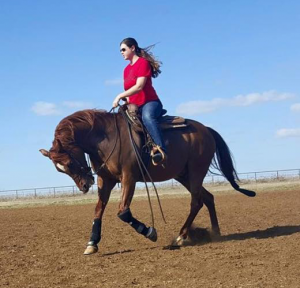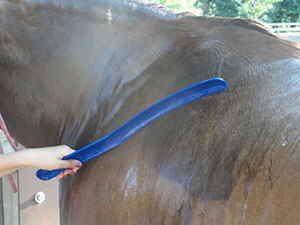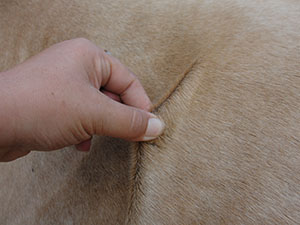
Managing horses during hot weather can be a challenge for horse owners. Horse owners need to provide extra care during hot weather in order to decrease stress and maintain health and well-being of the horse. Normally, horses cool themselves by sweating. Evaporation of sweat from the skin surface has a cooling effect (Figure 1). A horse that is working hard in a hot environment can lose 2 to 4 gallons of sweat per hour. Less evaporation occurs during times of high humidity. Table 1 outlines how a horse’s ability to cool itself is affected by air temperature and relative humidity.
The thermal neutral zone for horses is estimated to be from about 40°F (5°C) to 77°F (25°F), with the lower temperature representing the lower critical temperature and the higher temperature representing the upper critical temperature. It is commonly understood that horses require more calories to stay warm during the winter months. While not much is known about the impact of temperatures above the upper critical temperature on caloric needs, metabolic changes in nutrient utilization do occur. In addition, heat stress has a negative impact on feed intake, and most horses will not voluntary consume as much feedstuffs on hot days, similar to humans and other livestock. The change in metabolism, coupled with the likely reduced feed intake, can result in body weight loss, most specifically muscle protein. It is critical to track feed intake and body condition and weight during hot weather, especially for thin, older, and younger horses. If body condition or weight loss is observed, contact an equine nutritionist or veterinarian for assistance.
Table 1. How air temperature and relative humidity affect horse cooling
| Air temperature (°F) + Relative humidity (%) | Horse cooling efficiency |
|---|---|
| Less than 130 | Most effective |
| 130-150 | Decreased |
| Greater than 150 | Greatly reduced |
| Greater than 180 | Condition could be fatal if horse is stressed |
Fortunately, research has shown that horses can acclimate to hot and humid environments. A 15 to 21 day acclimation period is recommended for horses originating from cooler or drier climates that are traveling to compete or reside in hot, humid conditions. The acclimation period resulted in an increased tolerance to both heat and exercise. However, acclimation does not reduce the need for close monitoring of horses during training and competition in hot and humid environments.
To help reduce the effects of heat and keep horses comfortable:
- Provide turnout during cooler times of the day (early in the morning, late at night, or overnight).
- Provide relief from the sun through access to shade from trees or buildings. Shade will change throughout the day and constructed buildings may block natural air flow.
- Watch for signs of sunburn, especially on white or light-colored areas; use masks and ensure access to shade.
- Fans help to improve airflow; be sure to keep cords and plugs out of the horses reach to prevent electrocution.
- Ensure access to clean, cool (recommended temperature range of 45 to 64°F) water at all times. Depending on feed, an adult horse in a cool climate will normally drink 6 to 10 gallons of water each day while at rest, and much more while working or in hot conditions.
- Water buckets and tanks may need to be cleaned more regularly in hot weather as algae and bacteria grow rapidly in warm water. Blue algae toxicity (which affects horses, pets, and other livestock) is more common in ponds or slow running streams during hot, dry weather.
- Free choice access to salt will encourage drinking. Loose salt is preferred over a salt block.
- Consider providing electrolytes to horses that have been sweating heavily or are expected to do so. If electrolytes are added to drinking water, also offer plain water since some horses dislike the taste of electrolytes and will drink less. Only use electrolytes that are formulated for horses.
- Reduce riding intensity and length; heat stress can affect any horse but is especially common in older, obese and out of condition horses. Young foals also tend to be more prone to heat stress and dehydration.
- Clip horses with long hair coats (i.e. horses with Cushing’s disease) to enhance cooling.
- Transport horses during the coolest part of the day. Ensure that trailers are well ventilated and offer water frequently. Do not park in direct sunlight with horses inside.
- Horses with anhidrosis have little or no ability to produce sweat; these horses are prime candidates for heat stress.
It is recommended to avoid riding a horse when the combined temperature and relative humidity surpass 150 (Table 1). If a horse must be ridden during hot and humid weather, or you live in an area where hot and humid weather is prevalent, it is essential to:
- Adjust your schedule (ride early in the morning or late at night).
- Keep the work light and include frequent breaks that allow the horse to cool down and regain a normal respiratory rate. Do not work the horse beyond its fitness level.
- Watch for normal sweating.
- Create airflow (use fans) and work the horse in shade when possible.
- Provide access to cool, clean water at all times and offer water frequently during work. There is no reason to withhold water from a hot horse.
- Call a veterinarian immediately if your horse stops producing sweat, breathes heavily, or becomes lethargic, distressed or uncoordinated.
To cool an overheated horse (rectal temperature exceeding 103°F), spray or sponge the horse’s head, back, neck, rump, and legs with cool water and immediately scrape the water off, repeating continuously until the horse is cool (Figure 2). This is an effective cooling method because heat is transferred from the horse’s muscles and skin to the water, which is then removed to cool the horse. It is critical to scrape the warmed water off immediately, or the water may serve as insulation and might actually increase the horse’s body temperature.
Adding ice to the water will increase the speed of cooling for very hot horses with rectal temperature exceeding 105°F. Although some believe adding ice will “shock” a hot horse, research has shown that using ice to cool a horse is safe. Ice baths have been found to reduce core body temperature and lower heart rates after intense exercise, and horses were also observed trotting more freely after an ice bath. If a horse is prone to tying up, do not directly apply ice water to the large gluteal muscles in the hind end, but focus on areas where blood vessels are more superficial (i.e. head, neck, back and rib area). Finally, do not place a sheet or blanket on the horse while trying to cool it. Blanketing will block the evaporation of water from the skin and is not recommended during hot and humid conditions.
 Figure 2. To cool a hot horse, spray it with cool water and immediately scrape the water off.
Figure 2. To cool a hot horse, spray it with cool water and immediately scrape the water off.
Prolonged exposure to high temperatures can result in heat stress, heat stroke, and complications such as dehydration, muscle spasms, and colic. Overheating can result from hot weather, high humidity, poor barn ventilation, prolonged exposure to direct sunlight, excessive work, transportation, or obesity. Signs of heat stress include a rectal temperature greater than 103°F, increased heart and respiration rates, profuse sweating, droopy ears, signs of fatigue, and dehydration with a prolonged skin tent of several seconds when the skin of the neck or shoulders is pinched (Figure 3). Horses worked hard in extreme heat and/or humidity may go on to develop signs of heat stroke, a very serious overheating condition in which rectal temperature rises above 106°F. Signs of heat stroke include rapid heart and respiratory rates that do not drop within 20 minutes of stopping exercise (Table 2), whinnying and distress, marked dehydration with dry mucous membranes and a prolonged skin tent of 4 to 10 seconds, marked muscle weakness, incoordination, and collapse.
Table 2. Vital signs of normal and horses suffering from heat stroke
| Vital sign | Normal adult horse | Adult horse suffering from head stroke |
|---|---|---|
| Rectal temperature (°F)* | 99.5 to 101.5 at rest; up to 103 during exercise | Over 105 |
| Pulse rate (beats per minute) | 30 to 44 | More than 60 |
| Respiration rate (breaths per minute) | 8 to 12 | More than 40 |
| *Rectal temperature usually underestimates true core body temperature | ||
Horses suffering from heat stress and heat stroke require immediate cooling. Heat stroke is an emergency that requires immediate veterinary attention. Treatment includes stopping all exercise, getting the horse out of the sun, using fans, spraying and scraping ice water to cool the horse, providing cool, clean water, and making electrolytes available. Horses with heat stroke often require treatment with intravenous fluids and electrolytes to restore hydration and normalize blood chemistry.
 Figure 3. A skin tent test can help assess dehydration status in horses.
Figure 3. A skin tent test can help assess dehydration status in horses.
Some believe that horses should not be allowed to drink unrestricted amounts of water when hot due to hyper-distension of the stomach leading to colic. A horse’s stomach can hold between 2 and 4 gallons of fluid without becoming excessively distended. Allowing a hot horse a few swallows of cool, clean fresh water every few minutes is necessary to combat the effects of heat stress. Also, some believe that a draft will make a wet horse susceptible to a “chill” during hot weather. Fans (or natural air flow) work to increase evaporation and speed the cooling process. More effective are misting fans; misting is commonly used in the livestock industry to speed cooling in geographic areas affected by high temperatures. Though summer is an obvious time for heat-related issues, unexpected warm weather can contribute to overheating, especially if horses are out of shape and have long, thick coats.
Source: University of Minnesota Ag Extension
Reviewers: Kim Otterson and Missie Schwartz
Photo credits: Krishona Martinson, PhD, University of Minnesota